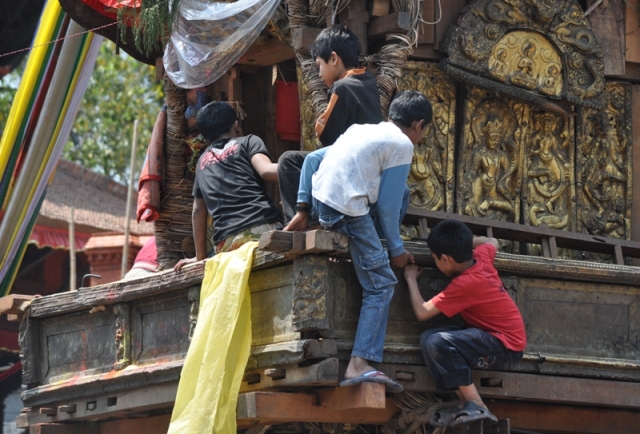April has been really busy for me. Within 10 days i went to Ghode Jatra, the Newari Chariot festival, Seto Machhendranath, Chaitra Dasain , Ram Navami. Then there was New Years, Balaju Mela and Rato Machhendranath.
My job is to create a calender for all the festivals, with pictures and descriptions. It is really difficult to find information for when the festivals begin and with some of the rituals occurring on the same days it is often hard to know what you are watching. Some days i turn up to work and i'll be reading the paper and i find out i missed something. i don't know how Nepali people know when things are on because there is no advertising.
Anyway here are the first five festivals I covered this month...
Ghode Jatra was first. It is celebrated by the whole Kathmandu valley. Many people believe it is purely a display of Nepal’s military horsemanship. The festival is actually a festival celebrating the death of the demon Tudel who lived in Tundikhel.
The demon terrorized Kathmandu and stole children to eat. The people of Kathmandu worked with the government to create a plan to kill Tudel. It was said Tudel could not be killed by a human or a human made weapon. Tudel was killed when a white horse rode over him. Now the traditional of riding horses across Tundikhel is observed to keep the demon’s spirit from returning.
The modern day festivities involve a military display. There is a horse race and horse jumping. The event is held t the military park at Tundikhel and the public are not allowed access inside the park. People are allowed to watch through the fence. Many stand for hours in the sun to secure the best view for the event.
The same afternoon another festival takes place. The Chariot Festival is celebrated by the Newar community. It involves three Gods, Kankeshwori, Shankata and Bhadrakali, being removed from their temples and being carried through the busy streets of Assen and old city in Kathmandu.
A week later Ram Navami and Chaitra Dasain are held. Both festivals are linked to the same legend of Lord Ram’s victory over the Demon Ravan. Ram Navami is the birthday of Lord Ram and is celebrated all of Nepal. Most people simply visit their local Lord Ram temple to leave offerings. Janakpur city, in southern Nepal, is said to be the site of Lord Ram’s Wife’s father’s ancient kingdom. At the Janaki temple there is a large festival with a procession of elephants, bullock carts and many visitors dance and sing in the streets. In Bhaktapur people go to the River Hanumante to pay respect to Lord Ram and his faithful devotee, Hanuman.
Chaitra Dasain festival is held the next day to worship the Goddess Durga, considered the Mother Goddess. She is the embodiment of the creative feminine force and exists in a number of forms. The most well known of these are: Kali Devi, Parvati Devi, Lakshmi Devi and Saraswati Devi. The festival is a celebration of the victory of Lord Ram over Rawan but also acknowledgement of the essential role the Durga Goddess played in that victory. During Chaitra Dasain goats and ducks are sacrificed in large numbers to honor the Goddess. In the Kathmandu one of the best places to see the festival is the Bhadrakali Temple.
Seto Machhendranath is the chariot festival which begins on the eighth day of the bright fortnight of Caitra and lasts for three days. The attendants (guthi) carry the deity and place it in a large wooden chariot. The chariot is built at Jamal and then in the evening the chariot is pulled through the street by the public. On the second day the chariot is pulled from Assen to the old palace area and the third day the festival ends in Lagan.
The legend states that Gorakhnath wanted something comfortable to sit on while he meditated. He saw the Basuki snake, the being which was responsible for bring the rain to the valley, and decided to sit on it. As Gorakhnath’s meditation stretched on for day the valley began to dry up. The people where very worried. They tried to raise Gorakhnath from his meditation but he would not be disrupted.
At last the people came up with a plan to call Gorakhnath’s older brother, Machhendranath. They reasoned if Machhendranath came to earth Gorakhnath would stand in welcoming and the snake could escape. A great ceremony was organized with many Pujas. The living Goddess Kumari was called on to greet Macchhendranath. When he arrived Gorakhnath was forced to end his meditation and stand. The snake quickly slid away and the next day the rains returned.
Seto Machhendranath began in the seventeenth century when Patan and Kathmandu split into two independent cities. The hostility between the two cities prevented residents from Kathmandu from viewing the Red Machhendranath festival in Patan. The King created the Seto Machhendranath for Kathmandu residents.
This was first published here but i wanted to show what I do for work so i did a naughty double post. I also went to Bisket Jatra.



Well, we have a calender hanging over here with a great deal of the nepali festivals on it. Otherwise my husband wouldn't know when what is or when to call to his family in Nepal.
ReplyDeleteYour post did a lot of memories arise. I was there during this time previous year. ;-)
Thanks for the stories behind the festivals!
ReplyDeleteI really enjoyed reading this thank you! Very informative :)
ReplyDelete